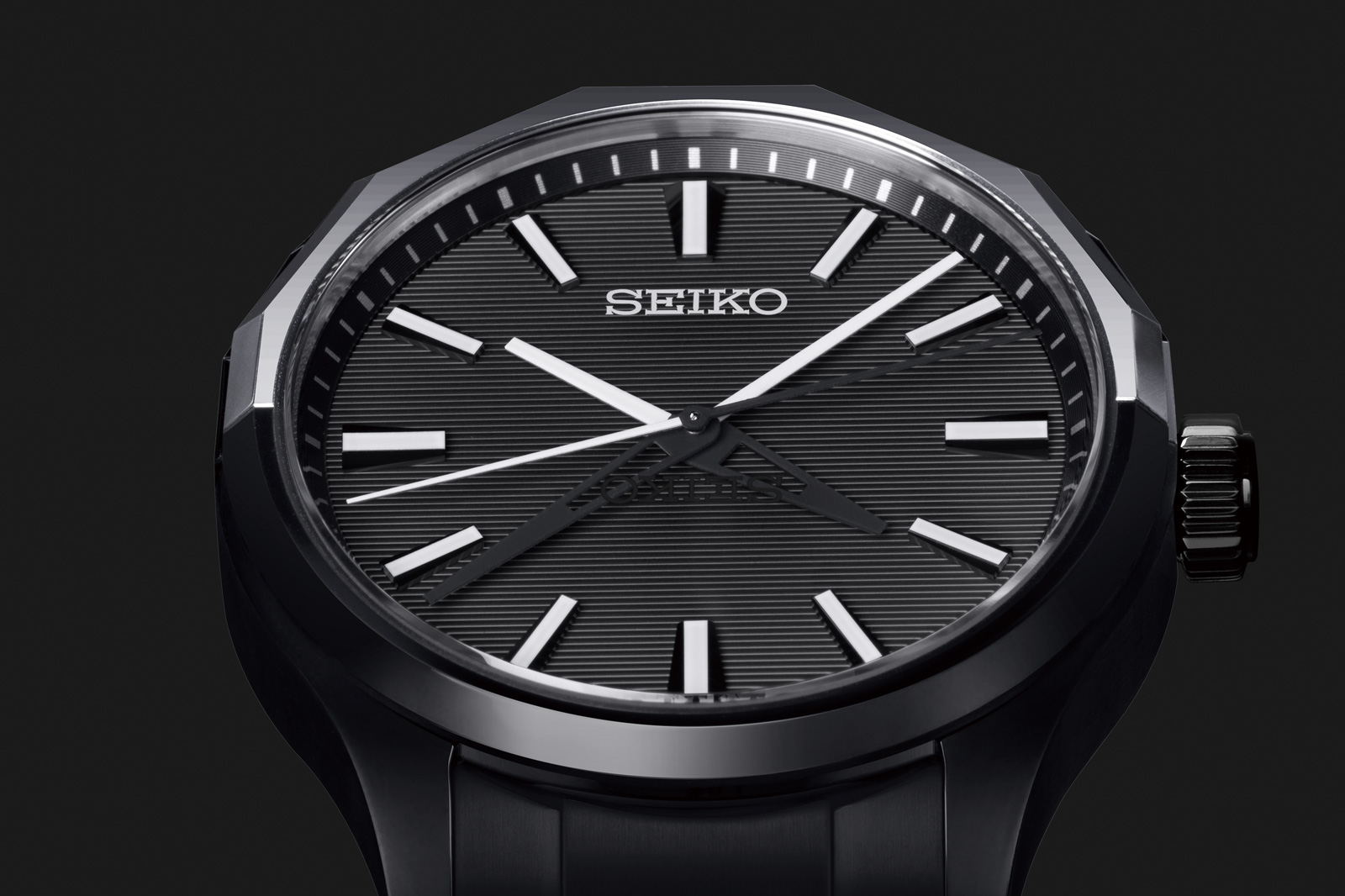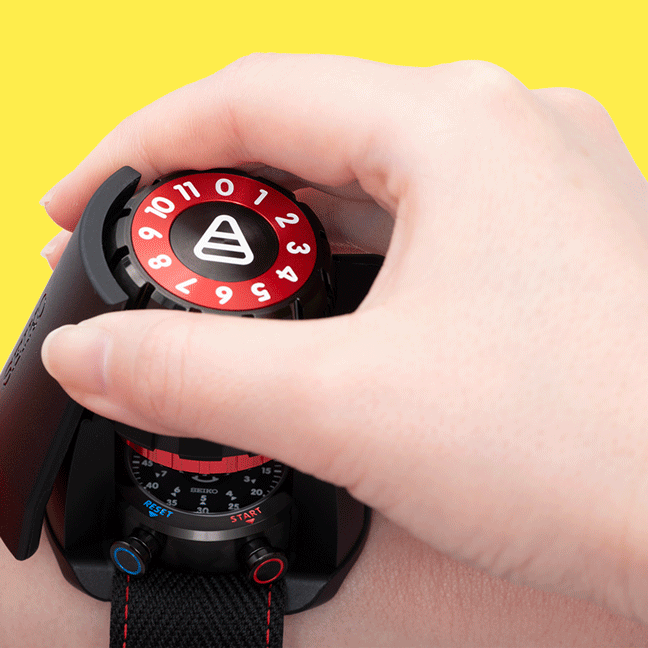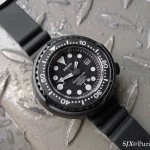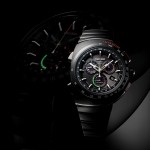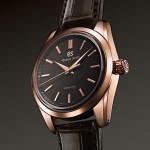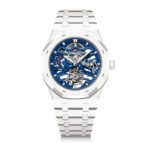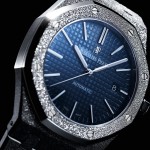Complicated watches are crucial to Audemars Piguet’s history, starting from its establishment in 1875 to the modern day; Audemars Piguet (AP) even supplied “ultra” complication movements to other brands in the late 19th and early 20th century. But it was in 2022 that the brand debuted its most impressive complicated watch – arguably the most impressive ever – the Code 11.59 by Audemars Piguet Ultra-Complication Universelle RD#4.
“Ultra” complications with multiple functions are de rigueur for important watch brands, from Patek Philippe to F.P. Journe, so the Universelle RD#4 is unsurprising given the status of Audemars Piguet as one of the traditional “holy trinity” of Swiss watchmaking. The Universelle RD#4 is surprising, however, in its execution.
The Universelle RD#4 is not merely another oversized and extremely complicated watch. Instead it has been thoughtfully designed to be unexpectedly user-friendly and wearable. In fact, the slim and sophisticated construction of its cal. 1000 is as much of an accomplishment as the long list of complications it offers. Put another way, the cal. 1000 is a masterclass in achieving the right balance between complexity, usability, and wearability.
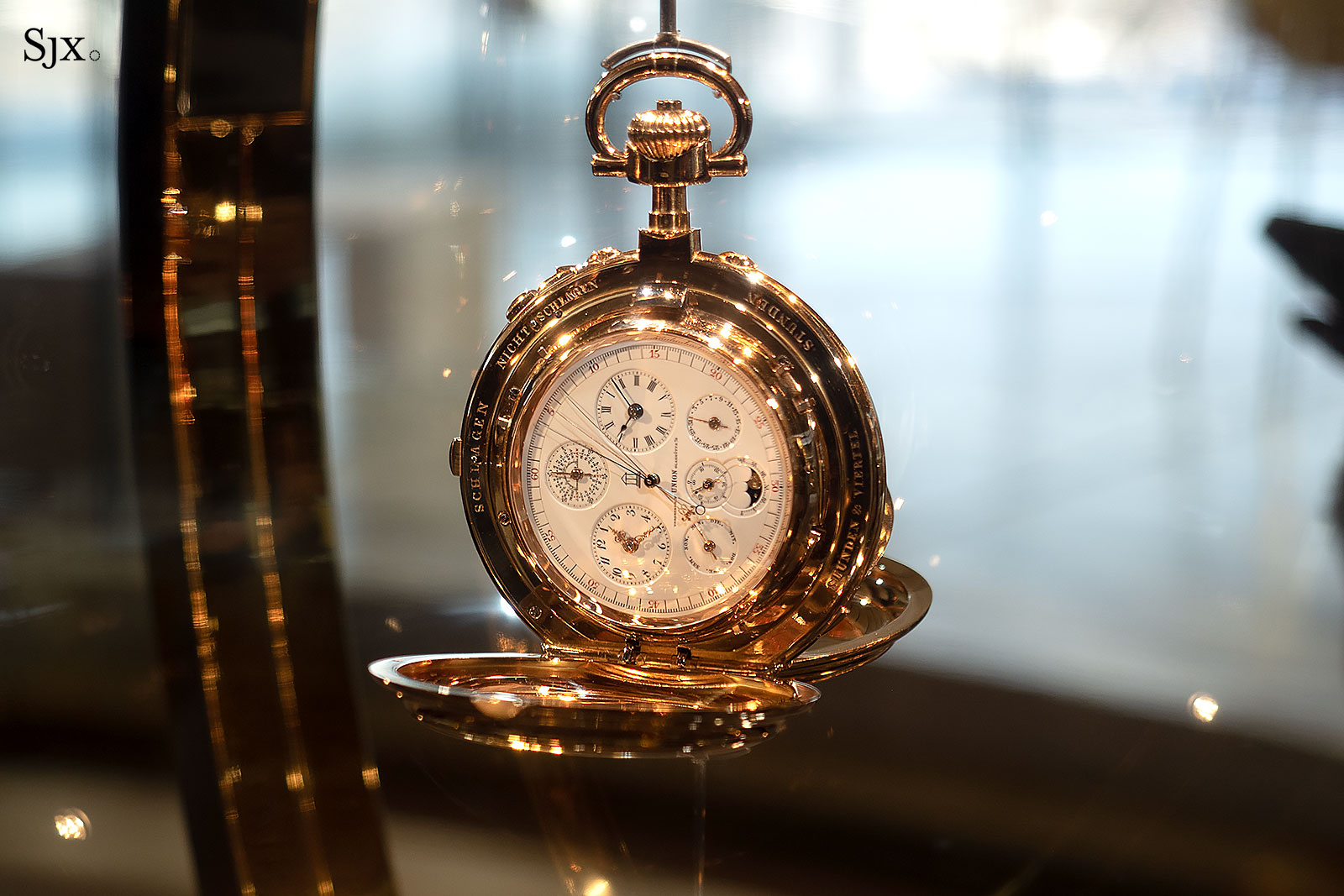
The historical Universelle pocket watch from 1899 in the Musée Atelier Audemars Piguet that served as inspiration for its modern-day namesake
An overview
The Universelle RD#4 is an “ultra” complication – there’s no other way to describe it. The watch ticks the boxes for the traditionally-accepted definition of a grand complication, minute repeater, perpetual calendar and split-seconds chronograph, but does even more than that.
Going beyond technical conventions was the goal of the Universelle RD#4, which evolved even further during its conception. As the project progressed, the watch gained additional complications, namely a flying tourbillon, grand et petit sonnerie, a novel moon phase indicator, and also an upgrade to the perpetual calendar that caters for 400-year cycles.
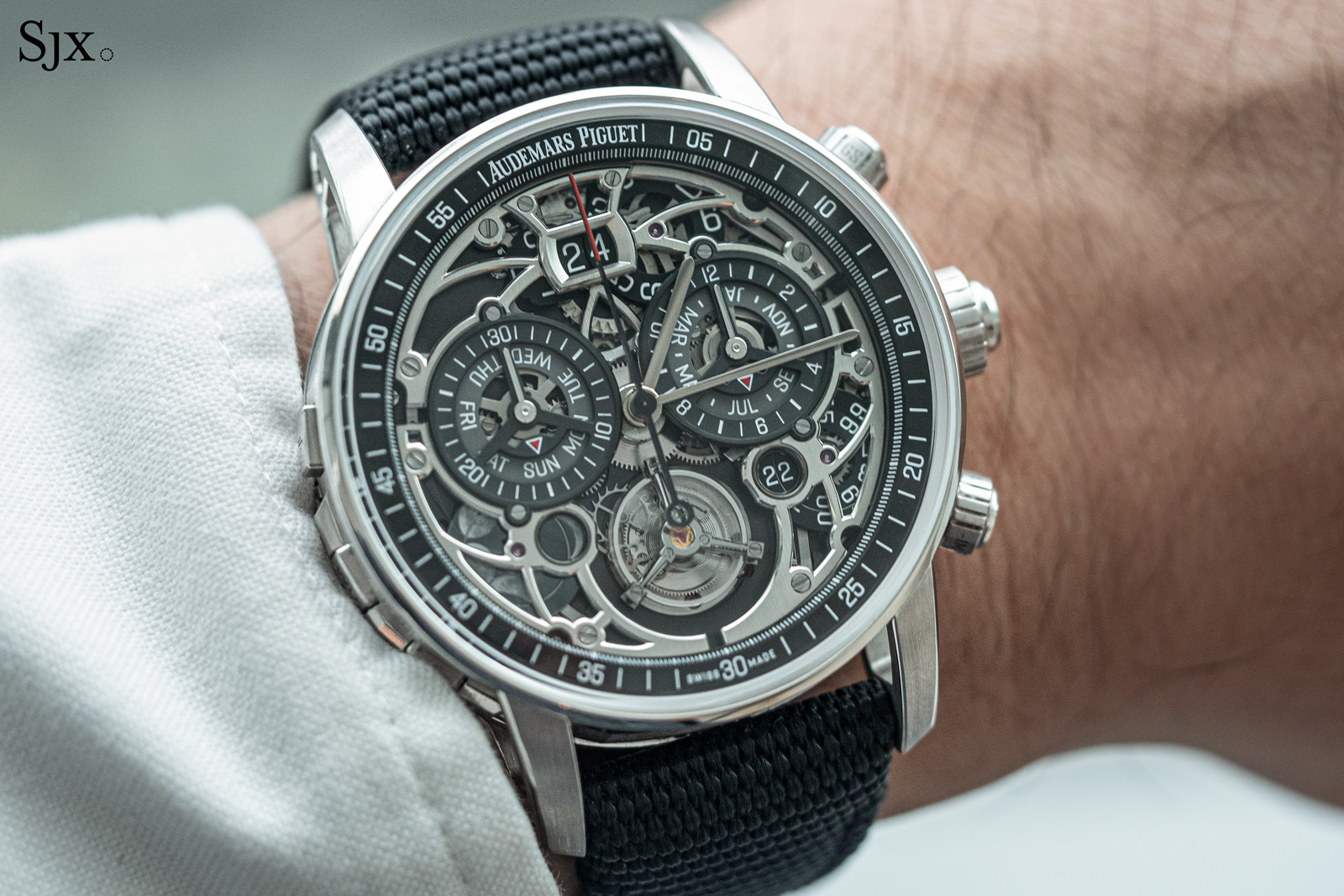
“Ultra” complications like the Universelle RD#4 have historically been a showcase of horological prowess that combine in as many complications as possible into a single wristwatch (or pocket watch). The user interface and ergonomics, however, were usually far down the list of priorities. To start with, such watches are often unwieldy due to a massive case resulting from a large movement. Additionally, they typically rely on multiple recessed pushers to adjust the calendar that are confusing since the pushers need to be matched with the indicator, and also require the watch to be removed from the wrist, then set with a stylus.
The cal. 1000 within the Universelle RD#4 breaks with tradition as its creators emphasised ergonomics and usability from the ground up. It was conceived as an “ultra” complication, but one with modern sensibilities that place ergonomics at the fore.
All of the functions of the Universelle RD#4 are accessible via pushers and crowns that are labelled and intuitive, doing away with the need for a stylus or any other tool. In fact, the wearer can operate all of the functions without even taking the watch off the wrist – practically unheard of for watches of this complexity – though it is of course advisable to first set the crown before adjusting anything else.
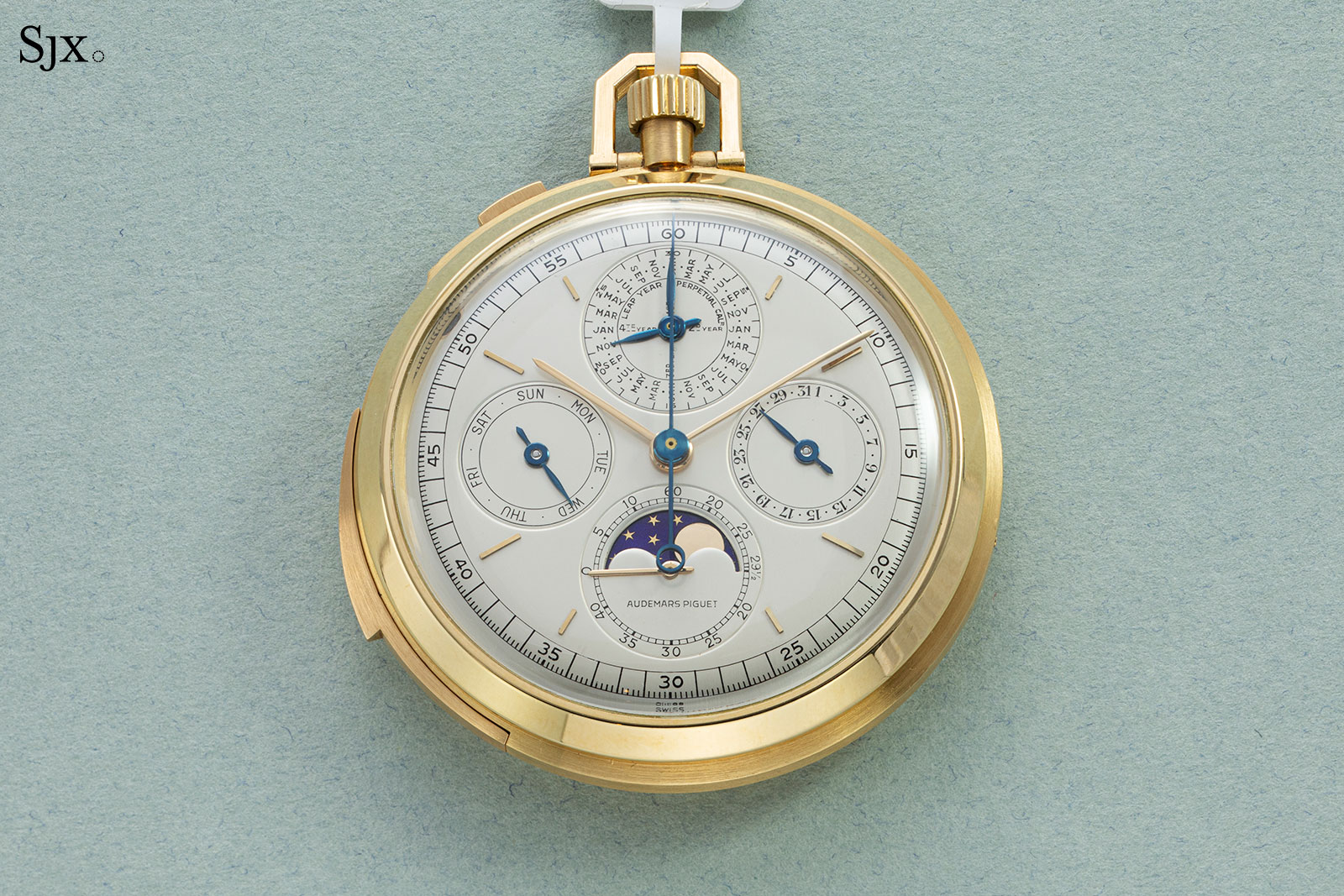
A traditional example of an Audemars Piguet grand complication pocket watch, this one sold in 1972 but equipped with a movement made in the early 20th century
A key aspect of the Universelle RD#4’s ergonomics lies in its thinness. This reflects the construction goals set from the get-go: the movement’s constructors were given a specific diameter and thickness at the beginning of the project. According to the development team, space constraints were one of the biggest challenges in development of the cal. 1000.
The final product stays well within those constraints – the cal. 1000 is a mere 8.8 mm high (and a bit thinner for the open-dial version) which, for a movement containing 1,140 parts, is exceptional. In comparison, the AP cal. 4401, an automatic chronograph with date, is 6.8 mm high.
When cased up, this includes the tall central hand stack and hinged hunter back, the Universelle RD#4 measures just 15.55 mm – or about the same as a Royal Oak Offshore 42 mm.
These accomplishments are the culmination of AP’s extensive watchmaking know-how, especially that of the braintrust at Manufacture des Saignoles in Le Locle, home to the complications department that was formerly known as Renaud & Papi. In technical terms, the cal. 1000 is best described as an aggregation of developments found in AP’s recent concept watches, the RD#1 Supersonnerie, RD#2 perpetual calendar, and RD#3 tourbillon.
Building upwards from the grand sonnerie
Fundamentally, the cal. 1000 is traditional in that it is built like historical multi-complications with modules stacked on the base movement, with the calendar complications on the front and chronograph functions on the rear. The unique nature of the cal. 1000 lies in the specifics of each complication and how they interact with each other and the wearer.
The base movement of the cal. 1000 incorporates a grand et petit sonnerie, with its architecture being based on from AP’s past grand sonnerie wristwatch movements, notably the cal. 2956 as found in the Grande Sonnerie Carillon Supersonnerie. Of all the complications in the Universelle RD#4, the grand sonnerie is the rarest and most coveted. Only a dozen or so brands have ever made a grand sonnerie wristwatch, and today only a handful do, most notably Patek Philippe, F.P. Journe, and Greubel Forsey.
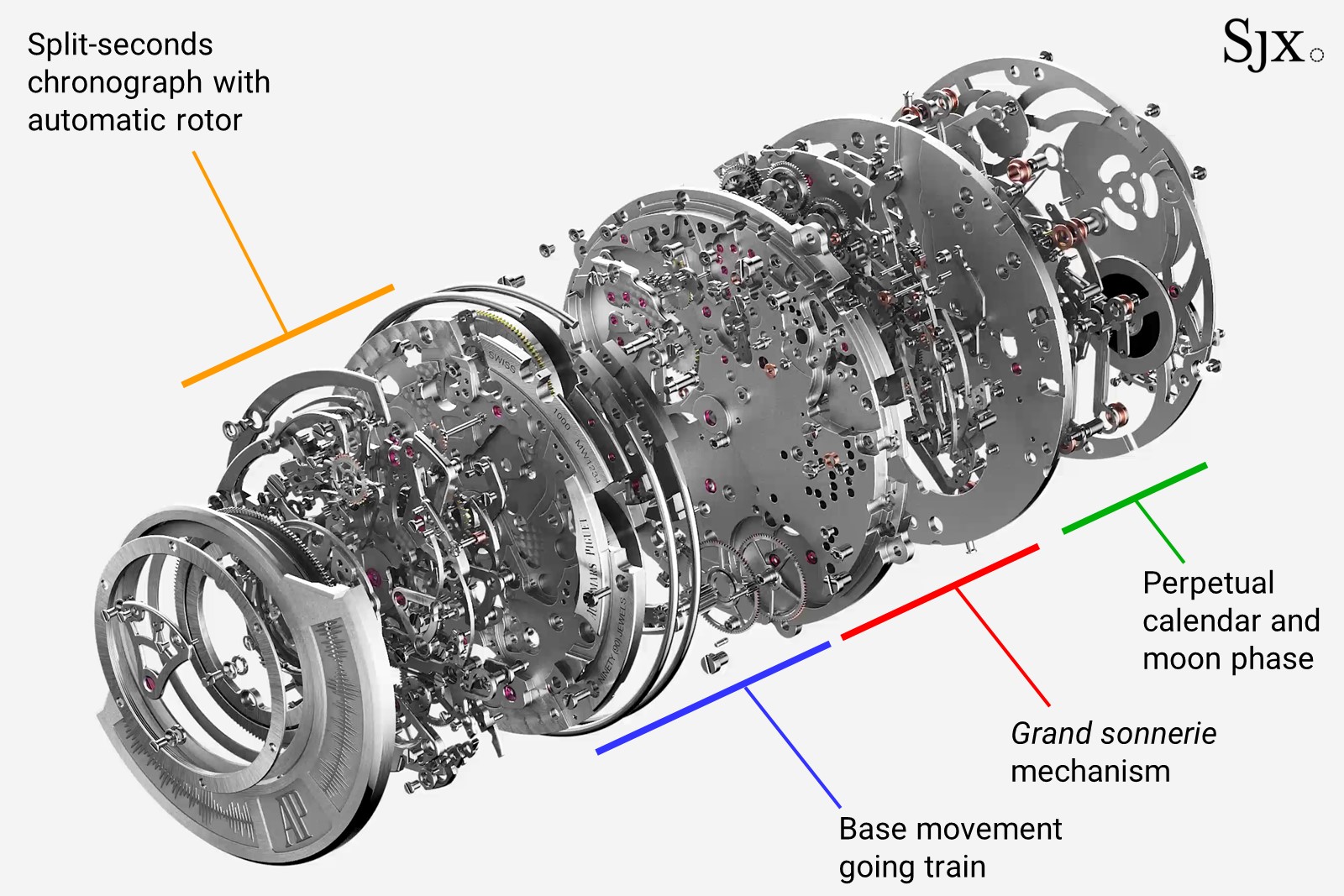
The layered construction of the cal. 1000
Like all of AP’s recent chiming watches, the Universelle RD#4 benefits from the innovations that originated in the RD#1 that debuted the patented Supersonnerie, a series of inventions enhance the acoustics of a striking watch, resulting in substantially louder and clearer chimes. Three patents form the underpinnings of Supersonnerie, with the most important being attaching the gongs to a metal membrane that forms the inner case back and serves as a soundboard that amplifies the chimes.
In the case of the cal. 1000, the inner back soundboard is actually a clear sapphire crystal display back, instead of the solid back found in past Supersonnerie models. The gongs are attached to the metal alloy rim of the crystal back, which allows it to both amplify the chimes and showcase the movement. But unlike earlier Supersonnerie watches, the Universelle RD#4 has a double back: on top of the display back is a hinged solid back that can be lifted to reveal the movement. The outer back has perforations along its edges to allow sound to escape from the case, in order to increase the volume of the chimes when the watch is on the wrist and the back is flat against the skin.
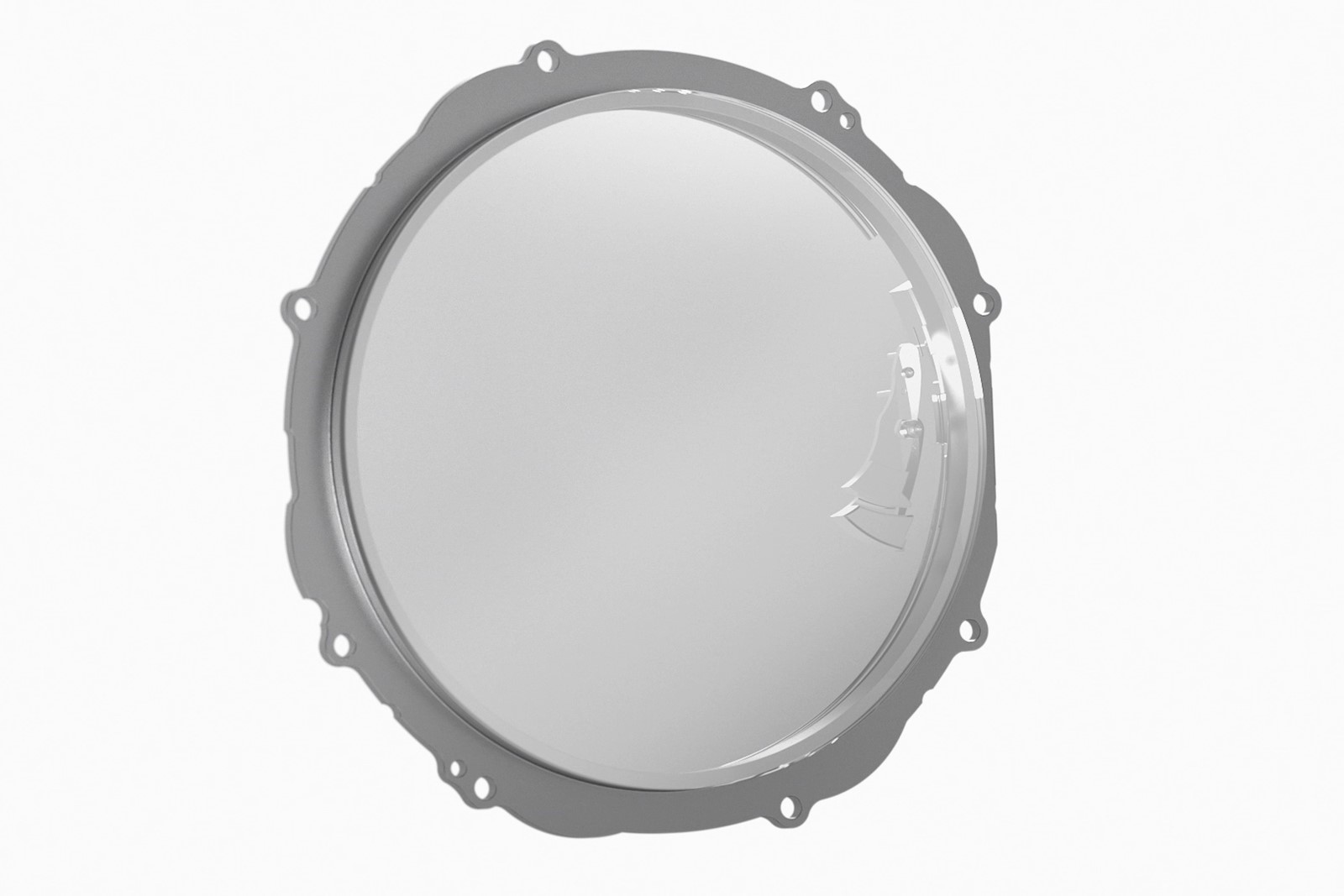
The sapphire display back serves as a soundboard for amplified chimes
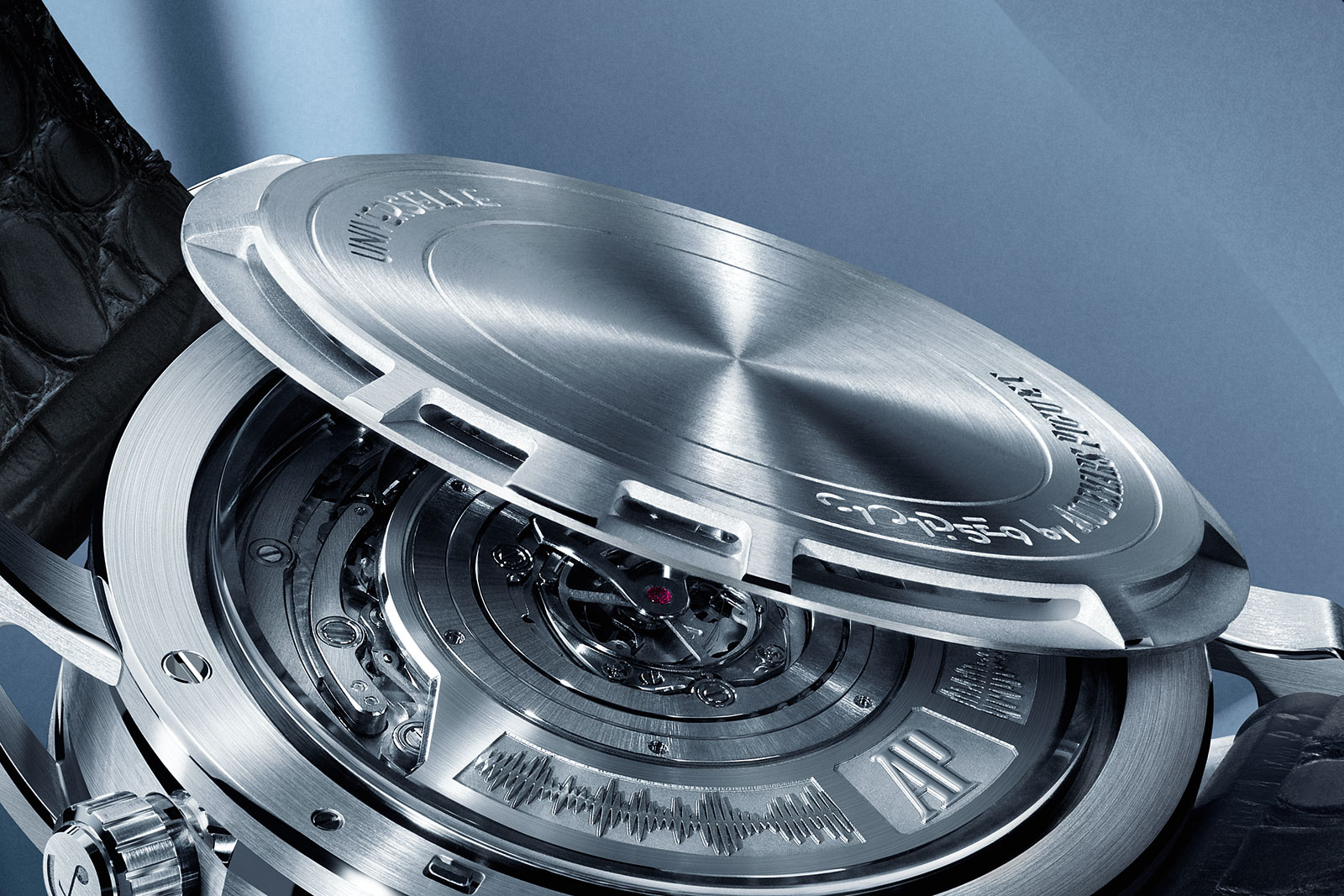
The back partially open, revealing the perforations along the edge
The cal. 1000, however, approaches the basics of the grand sonnerie differently from the earlier cal. 2956, and utilises a different arrangement of the barrels. Paradoxically, although the cal. 1000 is the newer calibre, it has a more traditional barrel layout.
Convention dictates two barrels are required for a grand sonnerie – one for timekeeping and the other to drive the automated chiming mechanism that strikes en passant. The cal. 2956 stacks both barrels vertically, which results in a smaller diameter movement of 29.9 mm but with an increased thickness of 5.88 mm.
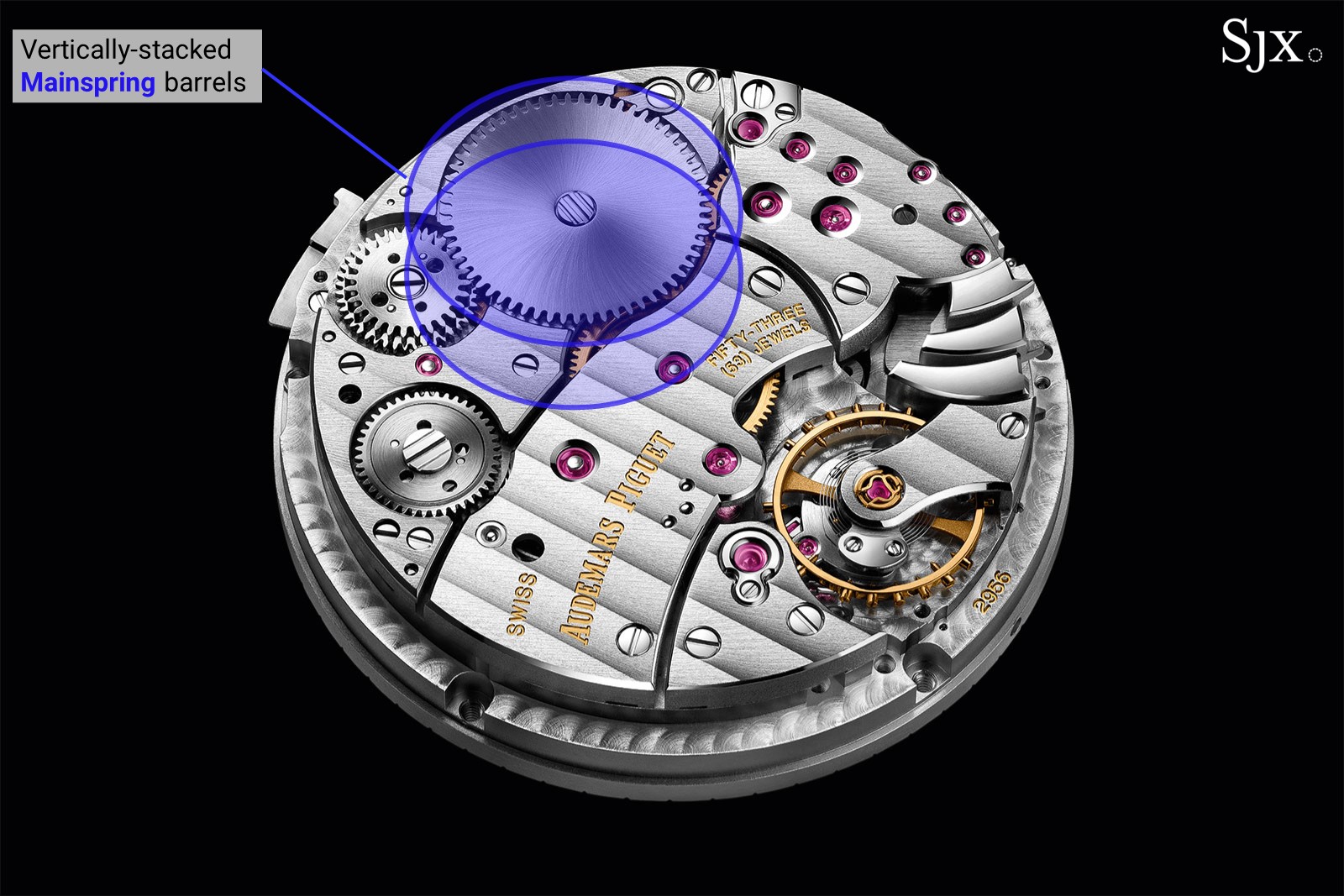
The cal. 2956 has two barrels stacked vertically hence only one visible barrel ratchet wheel
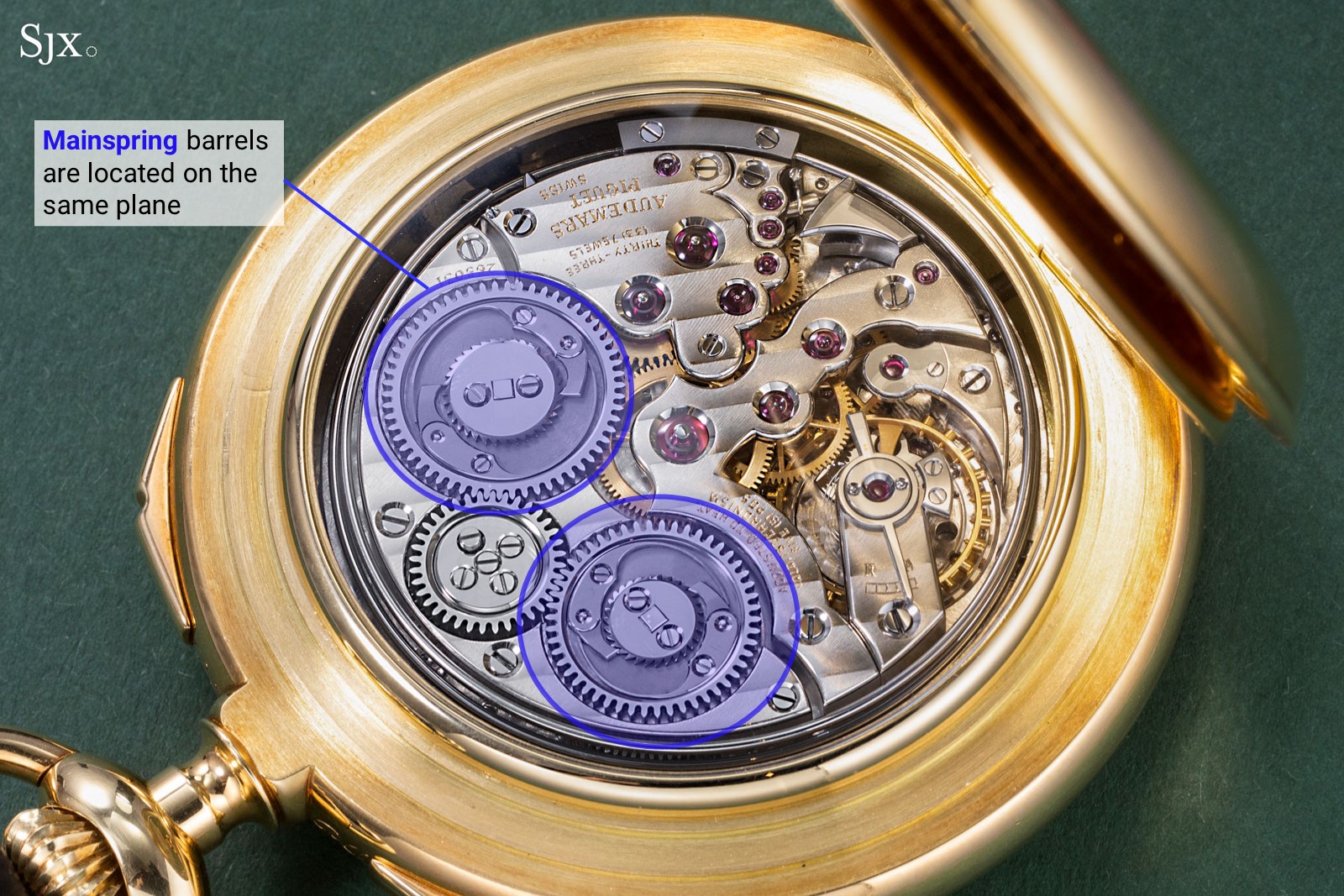
An Audemars Piguet grand sonnerie pocket watch made by Philippe Dufour with a traditional layout that has both barrels on the same lateral plane
The cal. 1000 however, has both barrels positioned side by side on the same plane, just like in a 19th century grand sonnerie pocket watch. This is possible due to the movement’s larger diameter of 34.3 mm, which is acceptable given the average size of wristwatches today. Spreading out the barrels reduces the height of the base movement, allowing the cal. 1000 with all of its complication modules to stay within its svelte 8.8 mm height.
The vertical space saving allows the cal. 1000 to have a full rotor for automatic winding of both barrels, which is particularly useful if the minute repeater is activated often. The rotor leads to the next innovation of the cal. 1000, the split-seconds chronograph mounted inside the rotor.
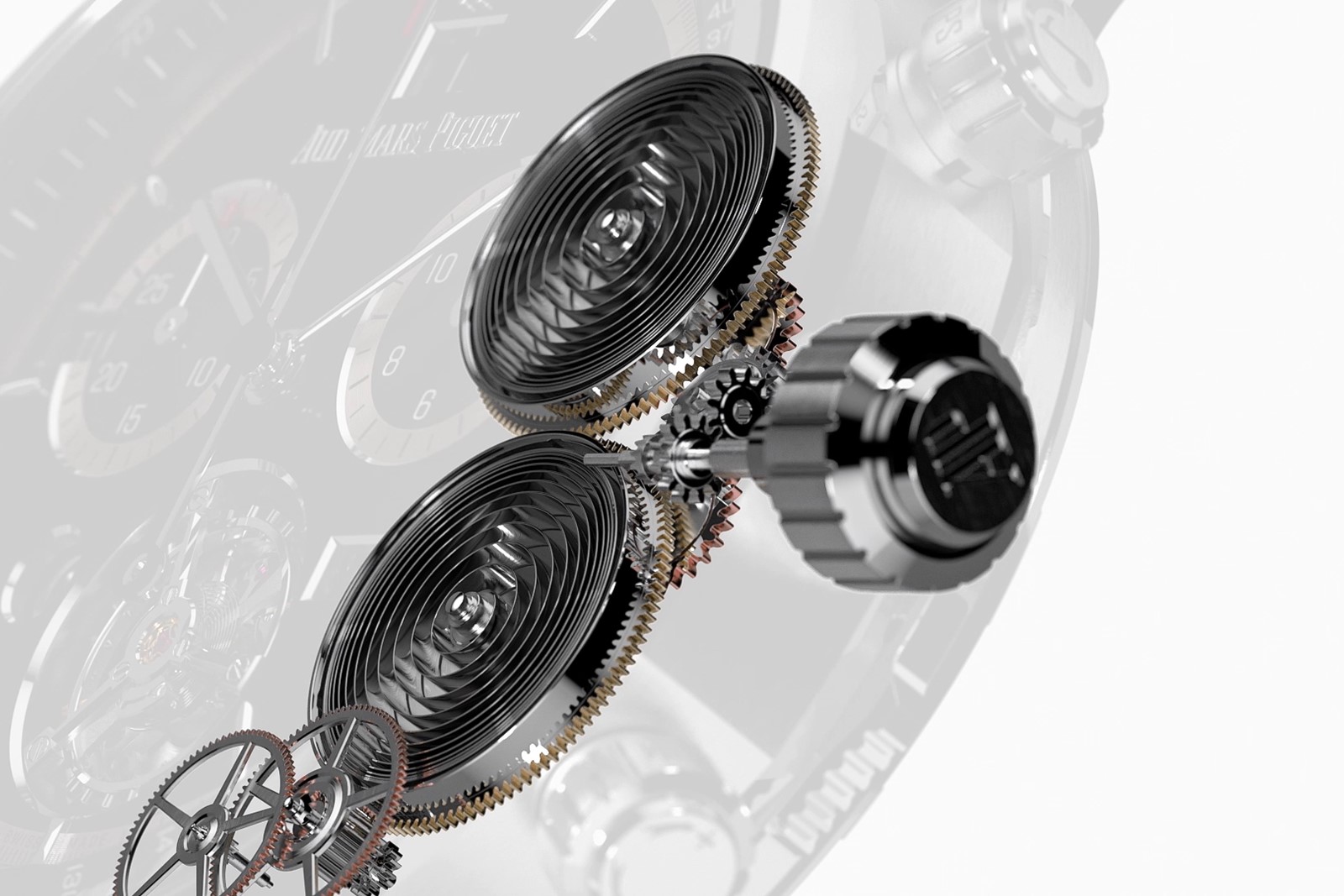
The twin barrels of the cal. 1000 with the smaller barrel (above) for the grand sonnerie, while the larger barrel drives the timekeeping going train
Compact rattrapante
When seen through the display back, the view of the cal. 1000 is dominated by the large rotor. But within and under the rotor is an unexpected mechanism, a full-fledged flyback chronograph with split-seconds.
The chronograph is of the lateral clutch type, which again is well suited to the large diameter of the movement since it requires more lateral rather than vertical space. When the chronograph is activated, the lateral clutch connects with the fourth wheel, which drives the tourbillon, to the central seconds, thus starting the chronograph. The chronograph mechanism also incorporates a flyback, allowing it to be instantaneously reset and restarted even when the chronograph is running.
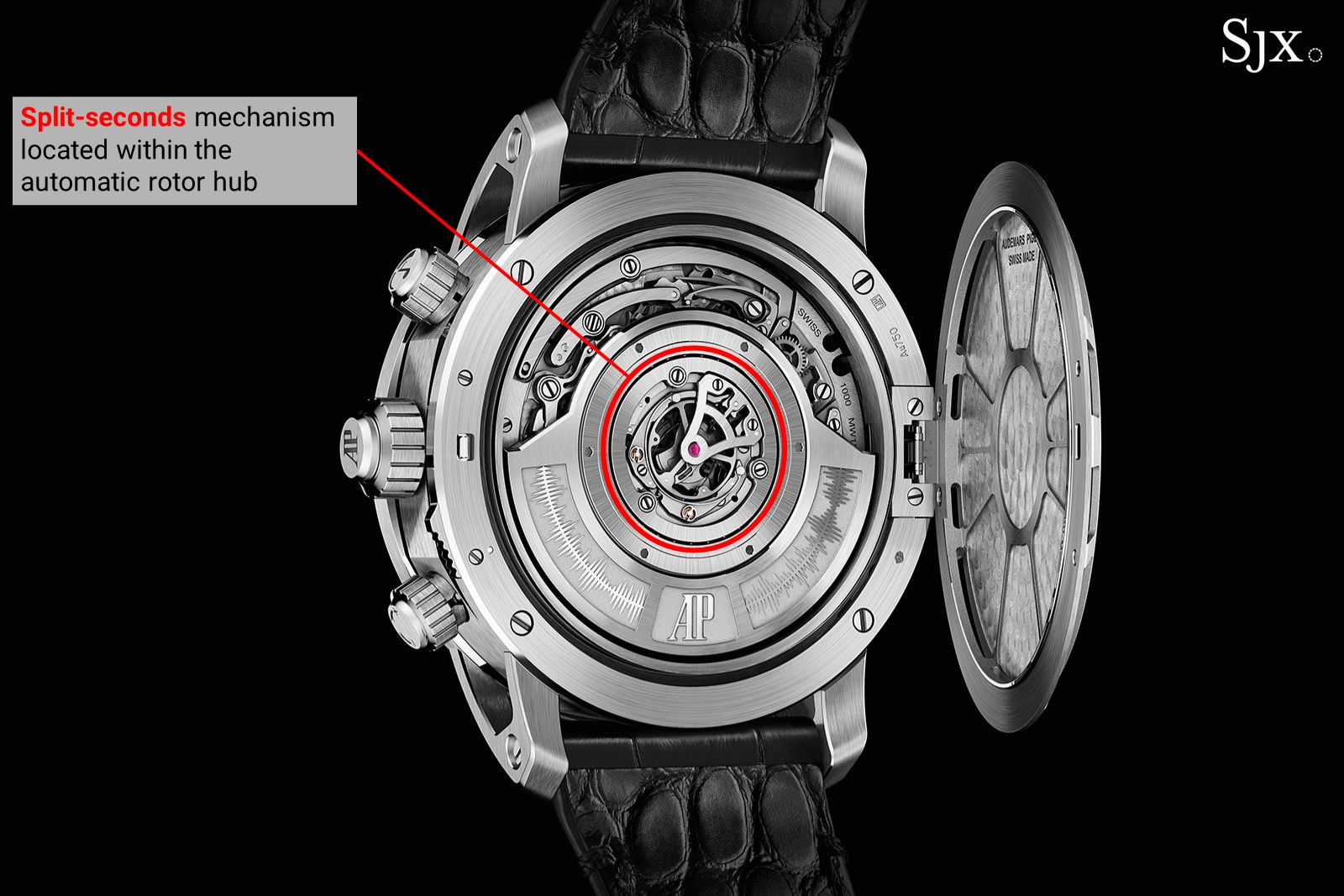
On top of the chronograph is the split-seconds, or rattrapante. Primarily consisting of a split-seconds wheel and a pair of brakes, a rattrapante traditionally adds significant vertical height to the centre of the movement. While this traditional approach adds visual depth to the movement, it adds substantially to the case height and also results in unused vertical space surrounding the centre of the movement.
These considerations resulted in the clever innovation found in the cal. 1000 that inserts the automatic rotor into that unused vertical space around the split-seconds assembly. Specifically, the rotor has an oversized bearing hub with an aperture in its middle that contains just enough room to house the complete rattrapante mechanism, including the tiny additional column wheel that controls the rattrapante brake levers.
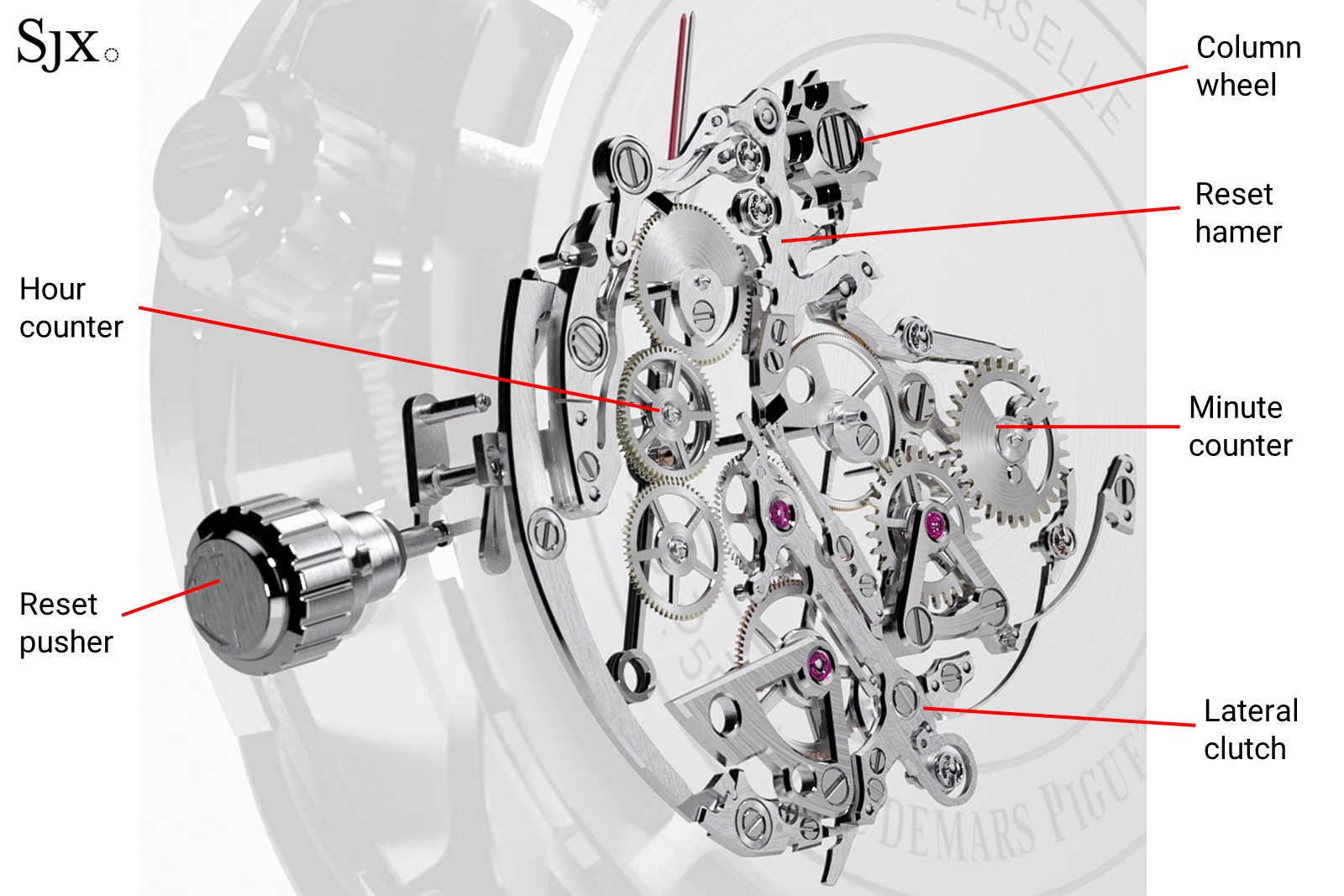
The cal. 1000’s flyback chronograph module without split-seconds
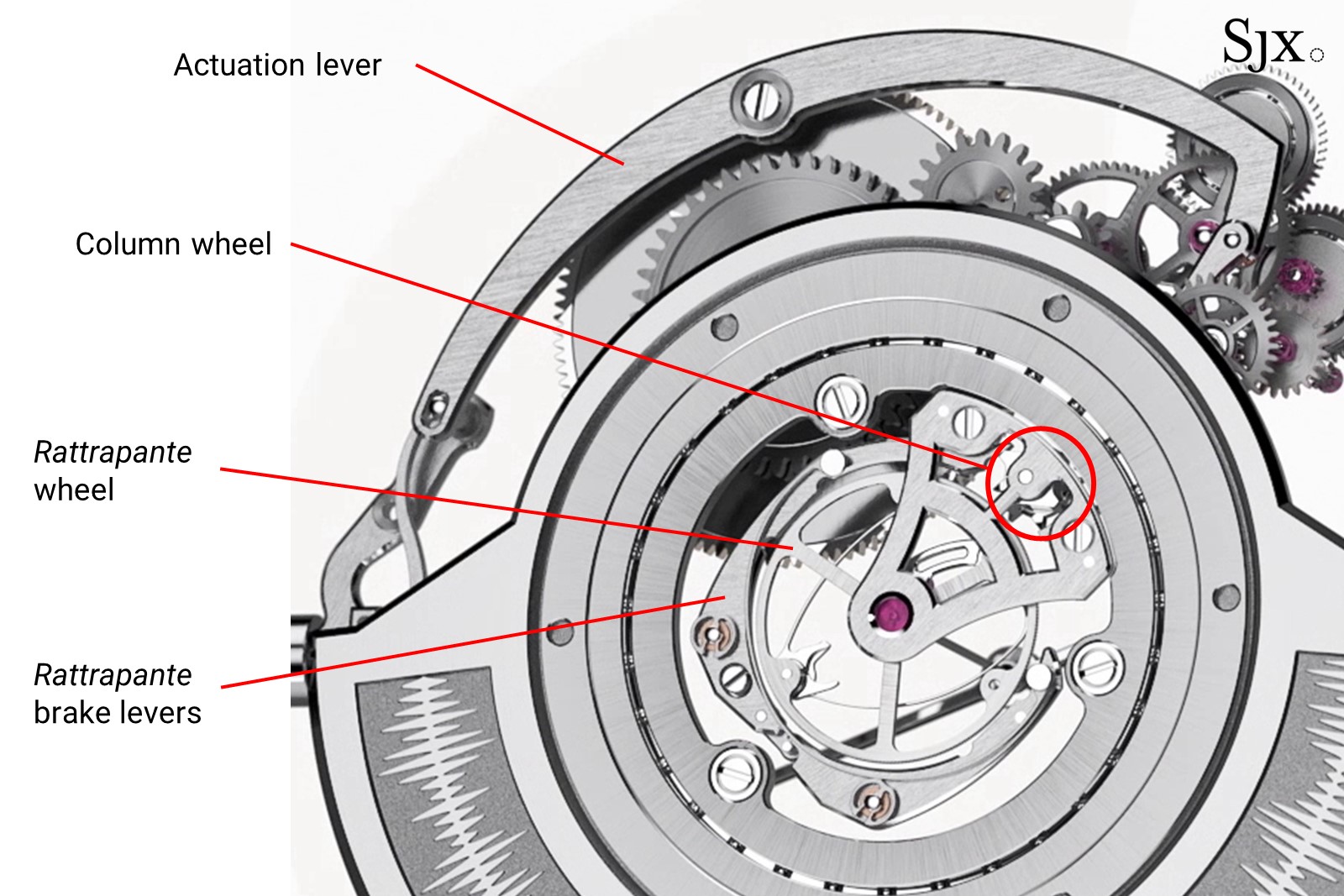
The split-seconds module is housed within the rotor hub
The central rotor design means the split-seconds and automatic mechanism occupy the same horizontal plane, eliminating the need to stack up one over the other, resulting in a height savings of about 1.1 mm. While the automatic winding mechanism is one of the simplest complications inside the cal. 1000, the execution is unquestionably one of the most ingenious. Notably, the combination of split-seconds and automatic winding is also found in the related cal. 4407 of Royal Oak Concept Split-Seconds Chronograph GMT Large Date, a more affordable (relatively speaking) option for someone who is a chronograph enthusiast.
However, while the chronograph mechanisms of the cal. 1000 are mechanically similar to the cal. 4407, the arrangement of the components are drastically different. Most notably, the chronograph in the cal. 1000 is configured to match the twin barrel set-up, where one mainspring drives the grand sonnerie, while the other powers the timekeeping going train and thus the chronograph hour counter.
Additionally, the Universelle RD#4 is a single-button split-seconds, so the rattrapante pusher of the cal. 1000 is co-axial with the crown, while the cal. 4407 has a separate pusher at nine o’clock.
In other words, the cal. 1000 chronograph is not merely transplanted from the cal. 4407, instead it was tailor-made to fit into the architecture of the cal. 1000, with an eye on utilising every little bit of space available.
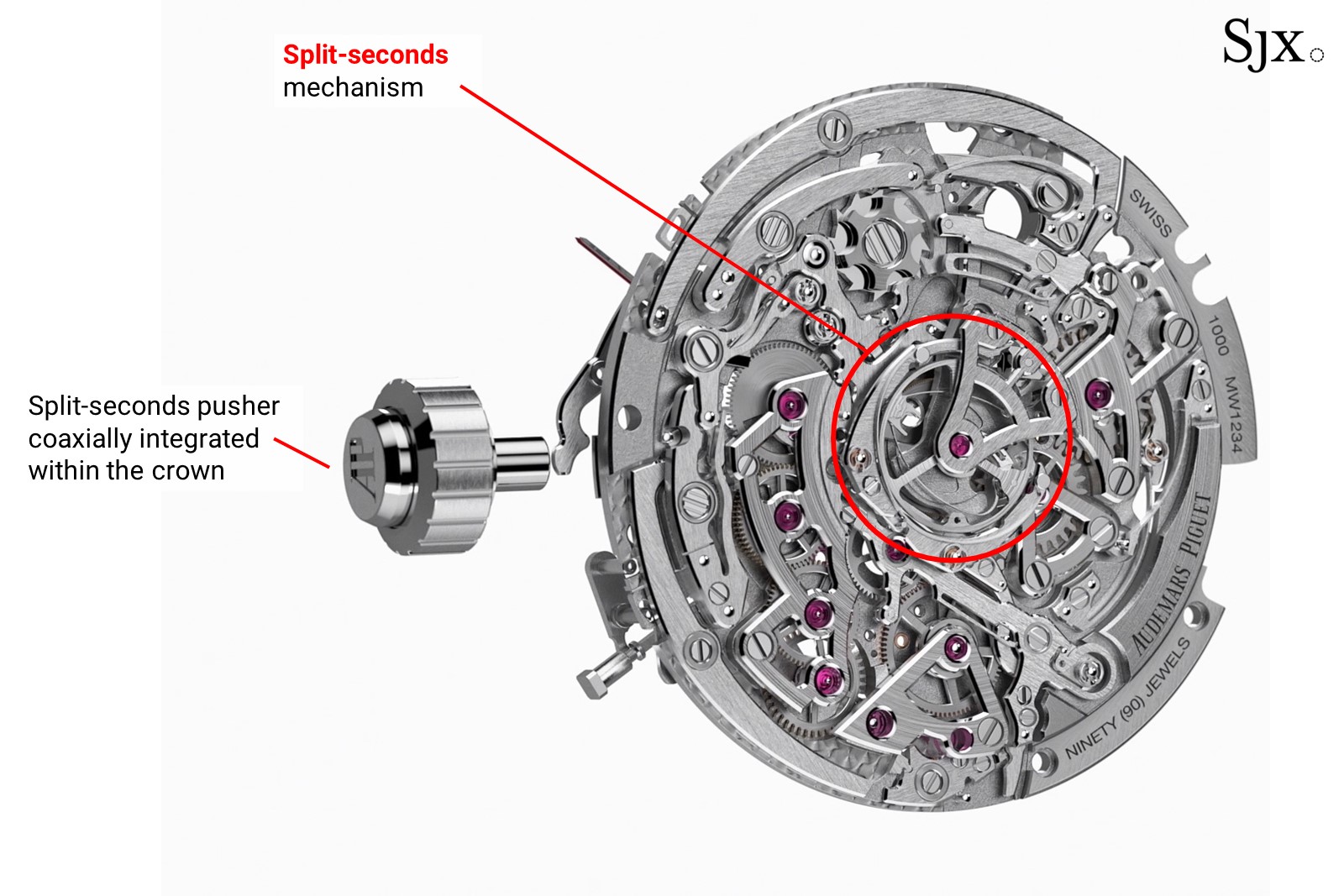
The cal. 1000 with rotor removed, revealing the split-seconds assembly at the centre
The calendar
In contrast to the dynamic and interactive chronograph that the wearer can repeatedly activate, the perpetual calendar is less flashy, but equally interesting in technical terms. To start with, the calendar display goes beyond the basics. While the day and month displays are in conventional sub-dials, the calendar also includes a two-digit year display at four, an oversized date at 12 o’clock, and a compact moon phase at eight.
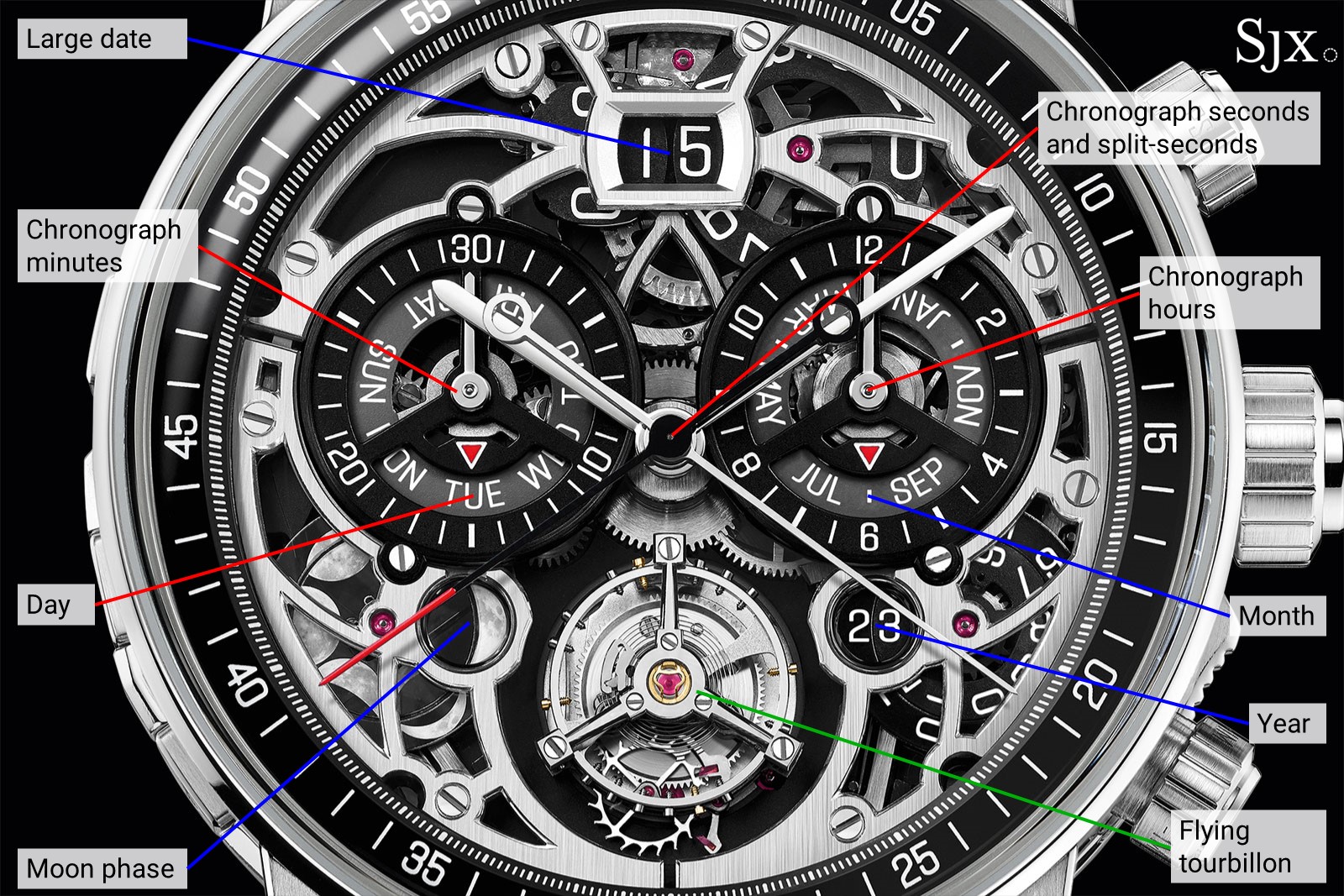
The complications visible on the dial of the Universelle RD#4
The cal. 1000 also approaches the mechanics of the perpetual calendar differently. To understand how, we must first outline how a conventional perpetual calendar functions.
At its heart is the programme wheel with multiple, irregularly-spaced steps with varying depths on its rim. These “steps” are a mechanical representation of number of days in a month – a shorter month will have a deeper groove and a longer one vice versa – over the course of 48 months, or four years, which is a one leap year cycle.
The grooves are sampled by the “grand” lever, a large finger that pivots into the current groove at midnight each day, thereby advancing the date by one step as midnight passes. Near the end of a month, however, the grand lever can pass over multiple days if it pivots into a sufficiently deep groove, which happens during months shorter than 31 days.
Typically, the parts of a perpetual calendar are stacked up in two or three layers. A conventional programme wheel, for instance, is made up of two co-axial wheels, making it two layers high. The cal. 1000, on the other hand, confines most of the perpetual calendar components to a single layer. This construction was adopted from the RD#2 that premiered the ultra-thin calendar mechanism condensing multiple layers of the perpetual calendar into one.

An example of a conventional 48-month programme wheel made up of two stacked gears
One of the key innovations in the RD#2 was flattening the programme wheel, which is also found in the cal. 1000. Instead of separate wheels stacked on top of each other, the cal. 1000’s programme wheel has grooves cut between each of its teeth, resulting in a single wheel that performs the function of two.
Because the calendar mechanism has been condensed in the cal. 1000, this frees up space for additional mechanical flourishes, most notably a big date instead of a conventional register-type indicator, which delivers better legibility, a quality particularly useful in a perpetual calendar.
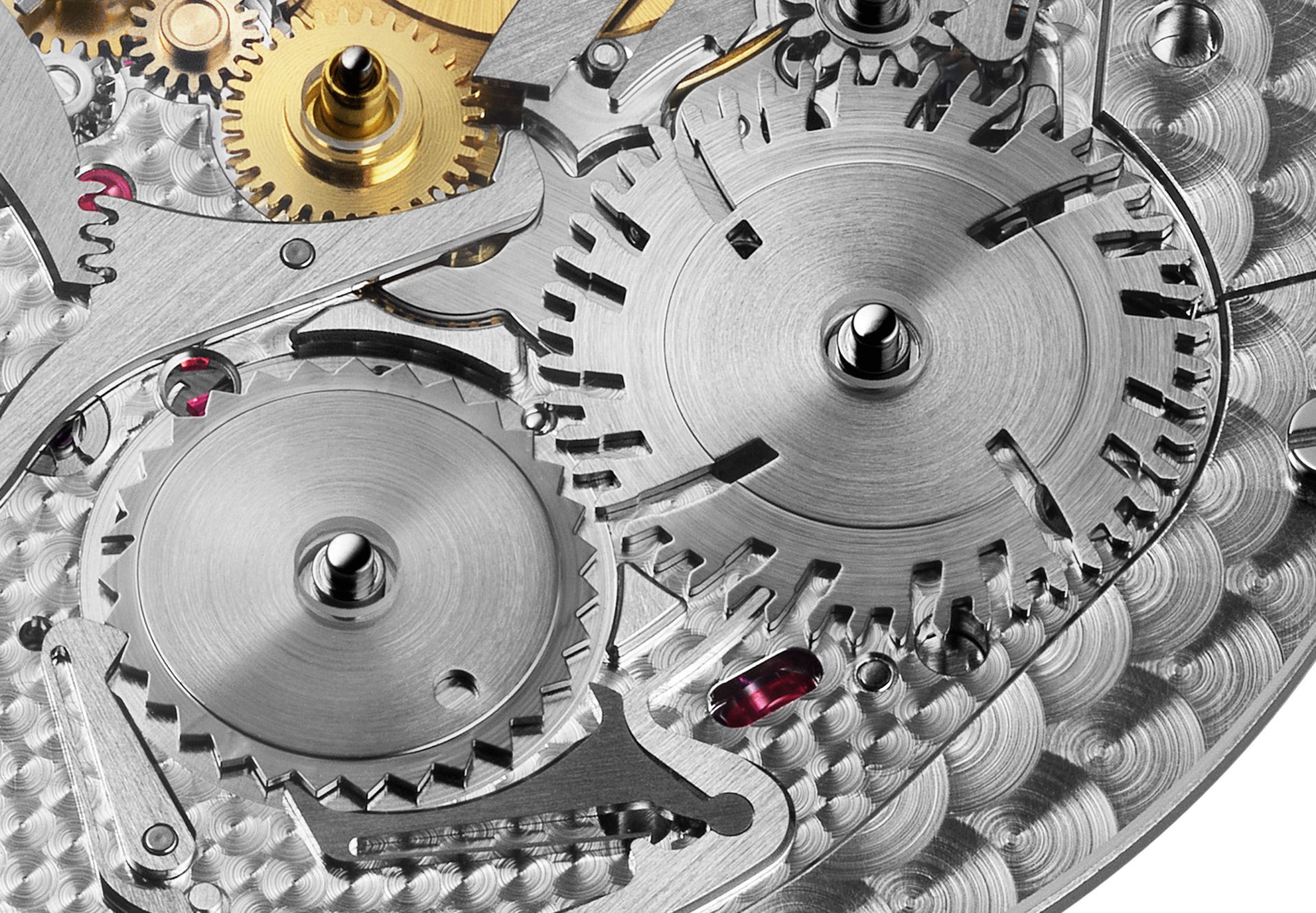
Th single-level, 48-tooth programme wheel of the RD#2
The cal. 1000 also takes the concept of “perpetual” calendar further. While the movement compresses the calendar mechanism, it extends the accuracy: the calendar is accurate for 400 years, instead of the 100 years that is the de facto standard in modern watchmaking. This is one of the biggest achievements of the movement, since it addresses the complex aspect of a perpetual calendar – accounting for leap years when February has 29 days instead of 28.
Perpetual calendars always account for leap years, which generally occur once every four years in the Gregorian calendar. However, there are exceptions to the rule – every 100th year that is not divisible by 400 is not a leap year. This results in a 400-year cycle and also means a conventional perpetual calendar is only accurate up to 100 years, as the years 2100, 2200, and 2300 are not leap years.
The cal. 1000 however, accounts for these once-in-a-century exceptions. It achieves this with a two-digit year display at four o’clock, which also serves to mechanically encode the leap years with a secondary programme wheel below the year discs. The grand lever thus samples both the 48-tooth month programme wheel as well as the separate year programme wheel to determine the number of days in February.
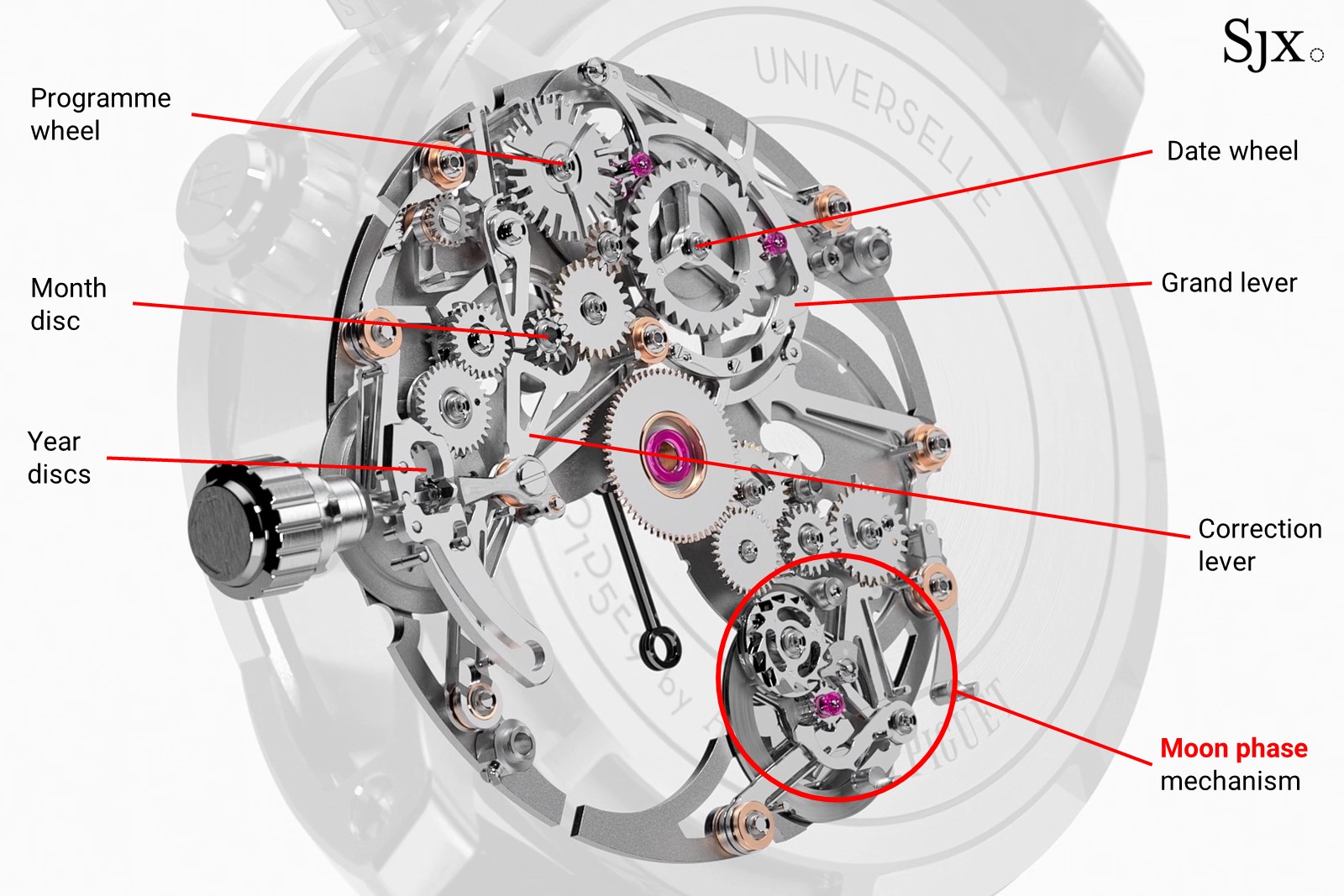
The perpetual calendar and moon phase mechanisms of the cal. 1000
Even though the Universelle RD#4 already does practically everything a watch can do, and then some, it would be even more impressive with a full-fledged perpetual calendar that can go beyond the 400-year cycle, otherwise known as a secular perpetual calendar (which some brands label a 1000-year calendar).
A secular perpetual would require much more complexity in configuration of the programme wheels, which would result in a thicker movement, compromising wearability. But that would further elevate the Universelle RD#4 in the rarefied strata of mega-complications.
Shooting for the moon
Although it is often overlooked, one of the most novel aspects of the calendar is the moon phase mechanism, discreetly tucked away at eight o’clock.
A conventional moon phase consists of a single disc with two circular moons that gradually completes a full rotation in approximately 59 days. The disc peeks out from a vaguely crescent-shaped aperture on the dial, gradually revealing the phase of the moon as the days pass.
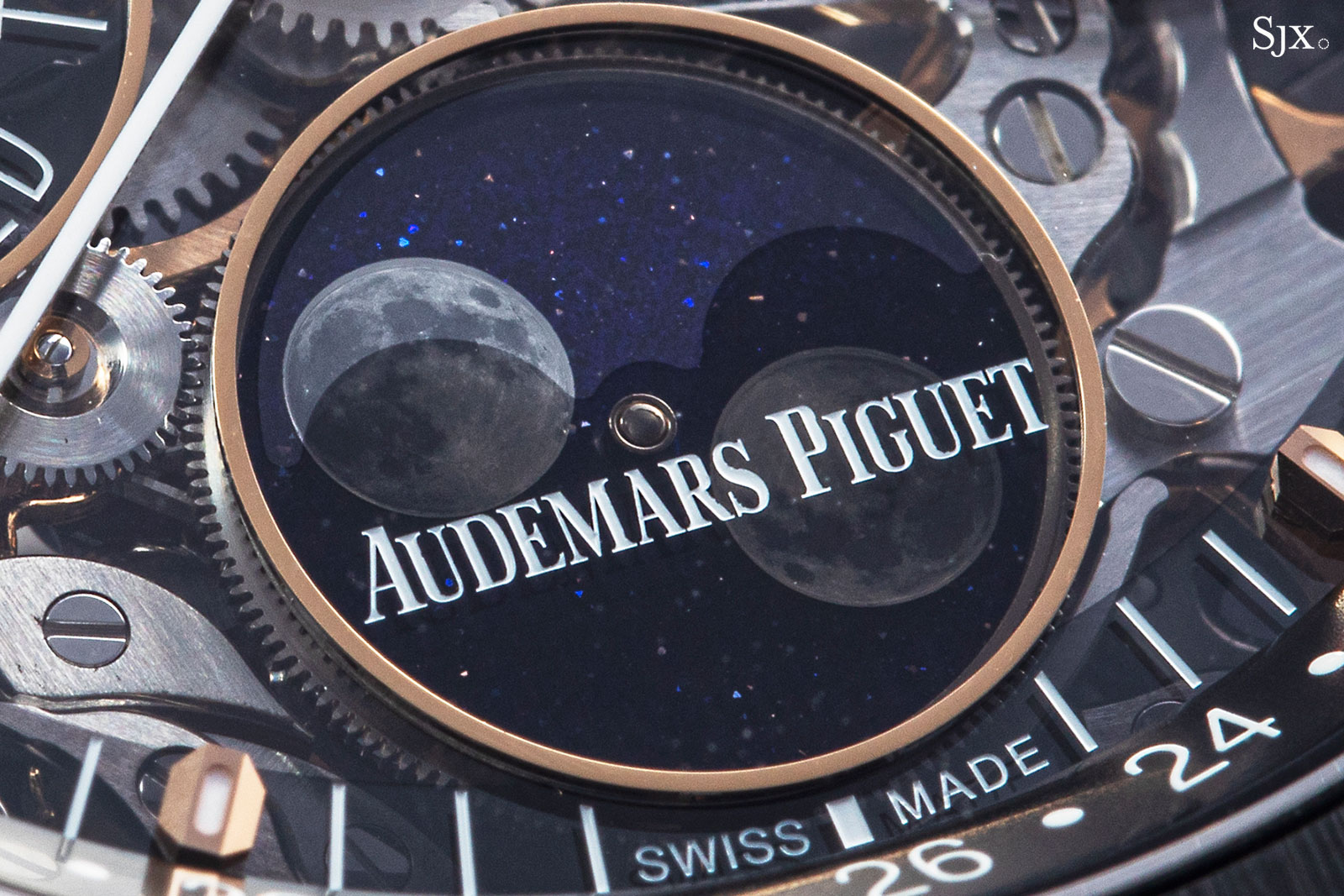
A conventional disc-type moon phase, seen here in the Royal Oak Perpetual Calendar Openworked
The cal. 1000 can’t easily accommodate such a display due to limited space on the dial, primarily because of the flying tourbillon that occupies the usual location for a moon phase. As a result, the moon phase is located at eight o’clock instead.
But the eight o’clock location means there is not enough space for a normal moon phase display. Thus, an alternative was born: an intriguing and inventive solution of two concentric discs that manages to both optimise available space and offer a more accurate display.
The double-disc display functions on the same principle as a big date, with each disc showing half the display; here each disc is printed with half a moon, and together the two display the specific age of the moon. This approach allows the moon phase to be contained within a simple circular aperture, which is a neater presentation given the space constraints on the dial.
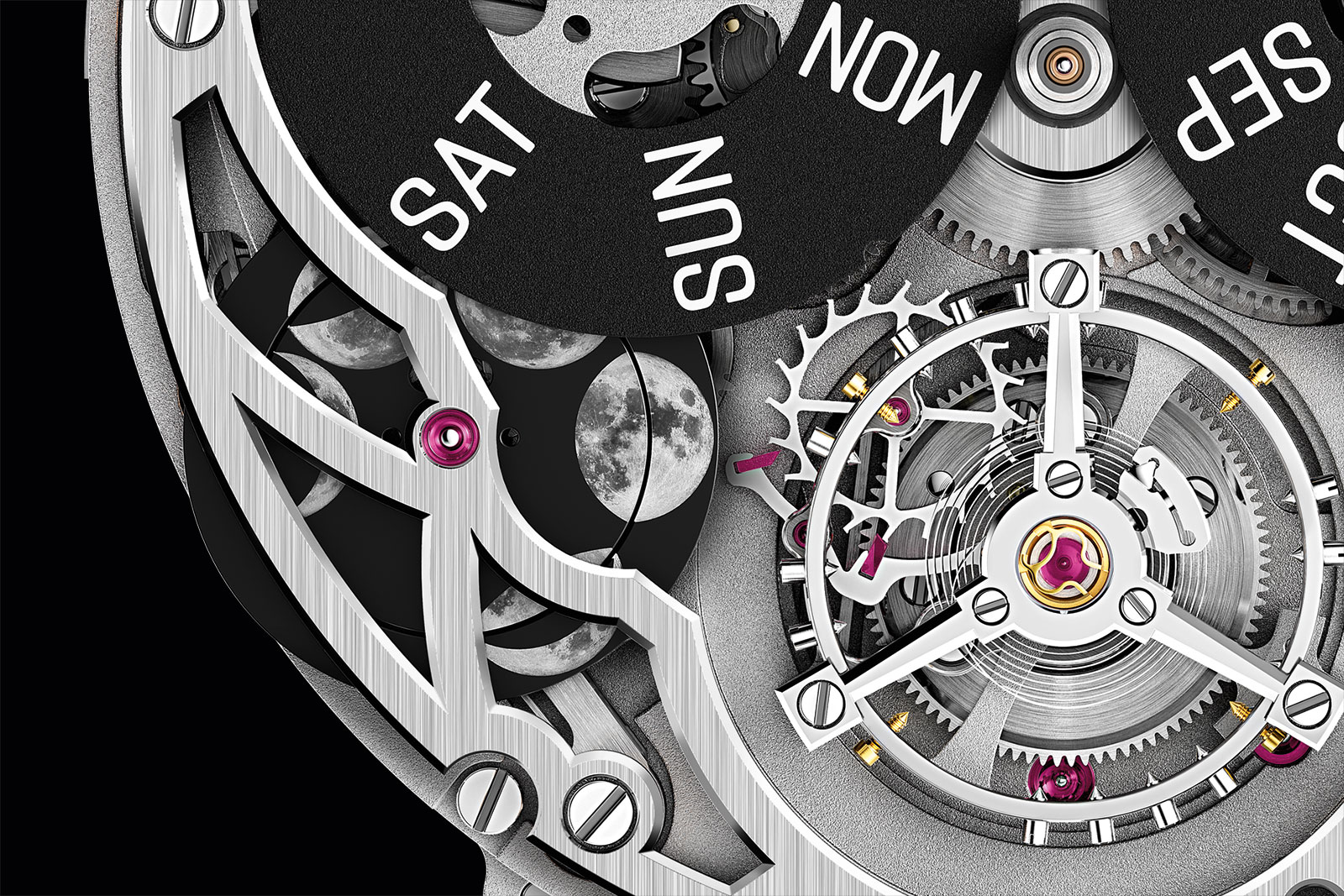
The double discs of the moon phase disc require minimal real estate, allowing them to fit on the relatively crowded dial
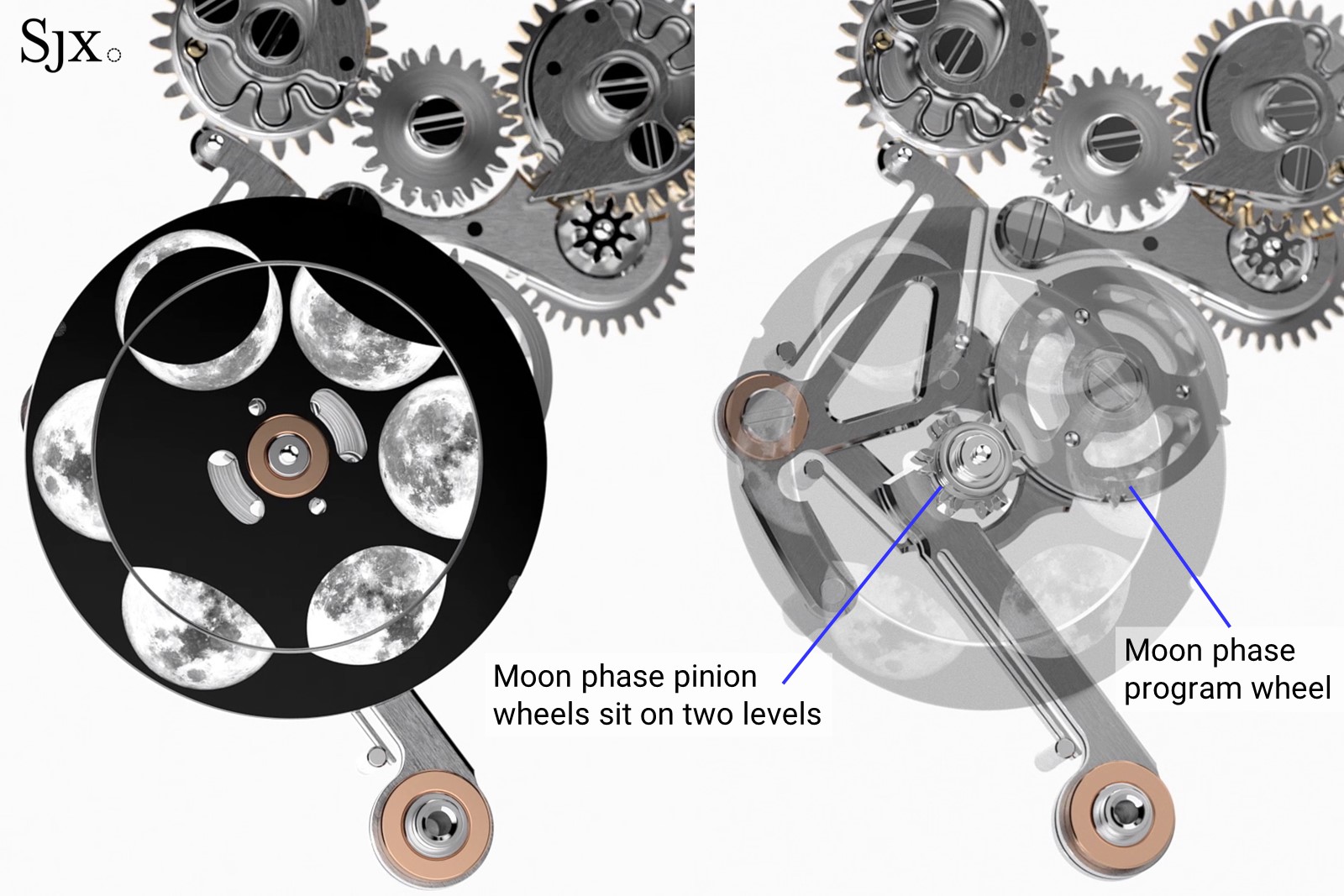
The moon phase mechanism of the cal. 1000, consisting of two concentric discs
Because the two halves of the moon are on separate discs, the moon phase is a more accurate representation of the moon’s age over a lunar cycle. In total, ten distinct representations of the moon phase are represented via these two discs, from full moon to waning crescent and so on.
As an aside, the moon phase mechanism is compact and not particularly complicated, making it fairly easy to incorporate into other movements. The small dial window required for this mechanism makes it especially useful in complicated dial layouts, and it will be interesting to see how AP implements this in upcoming calibres.
Multi-purpose pushers
Last but not least, it is worth discussing the pushers and adjusters of the cal. 1000. Their operation is startlingly simple, especially considering the complexity of the watch.
The left flank of the case is home to three rectangular pushers, each helpfully labelled for intuitive use. The topmost pusher (engraved with a treble clef) activates the on-demand minute repeater, replacing the traditional slider mechanism that requires more horizontal space.
The middle button (marked “WD” for day-of-week) advances the day, while the lower button (bearing a crescent moon) advances the moon phase.
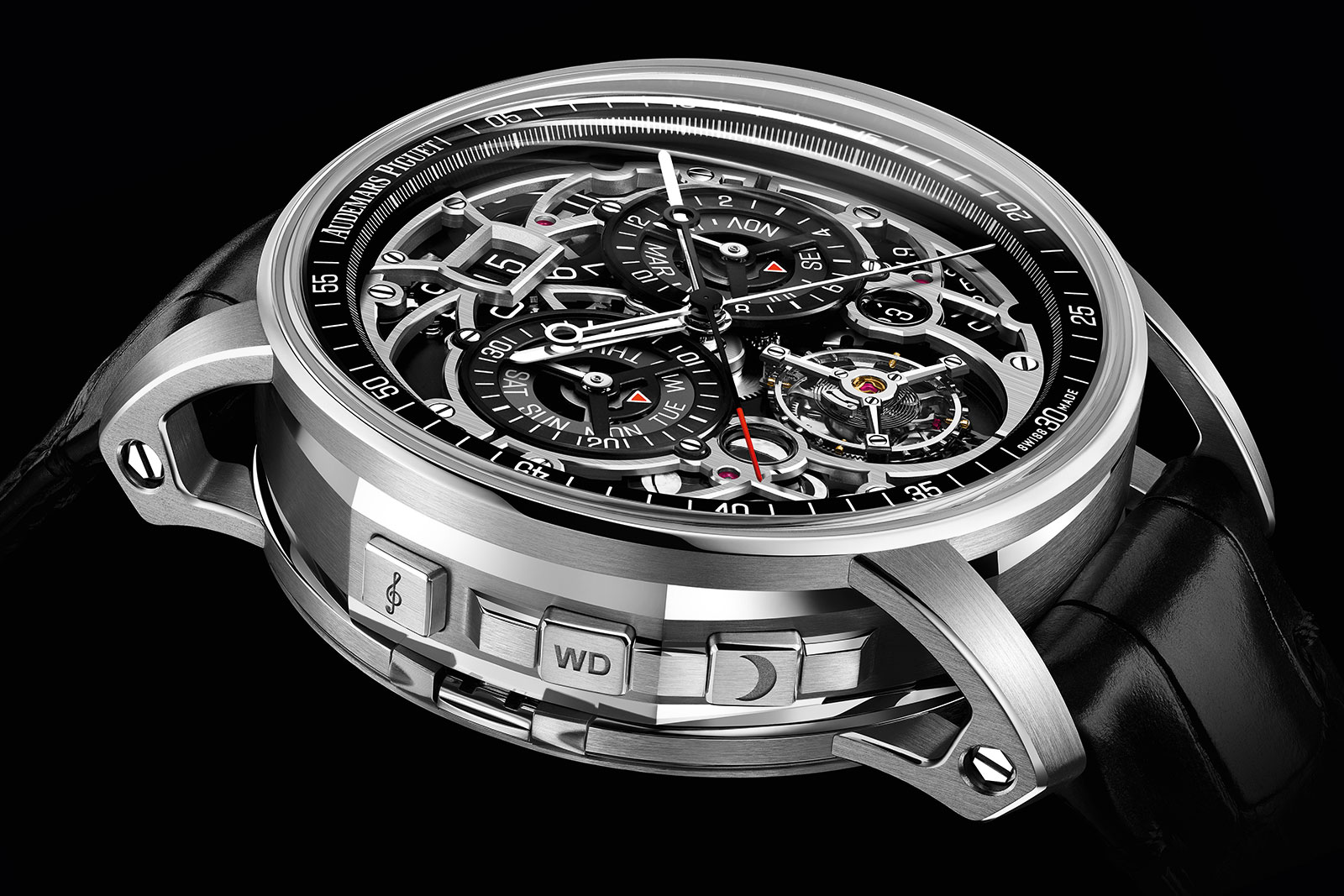
The three rectangular pushers on the left flank of the Universelle RD#4’s case
On the right side of the case are the familiar crown and chronograph pushers, all conventionally positioned. As expected, the pushers at two and four o’clock control the chronograph start and stop respectively, while the pusher embedded within the crown at three o’clock operates the rattrapante function.
Most interesting are the additional crowns situated co-axially with the chronograph pushers. In order words, each chronograph pusher has a movable ring around it that controls a movement function.
Rotating the upper crown at two o’clock toggles between three chiming modes for the grand sonnerie, a feature adapted from the cal. 2956. Grand sonnerie mode strikes the hours and every quarter in passing, petit sonnerie chimes only the hours in passing, and silent mode deactivates the clockwatch mechanism, leaving the watch to chime only on demand as a minute repeater.
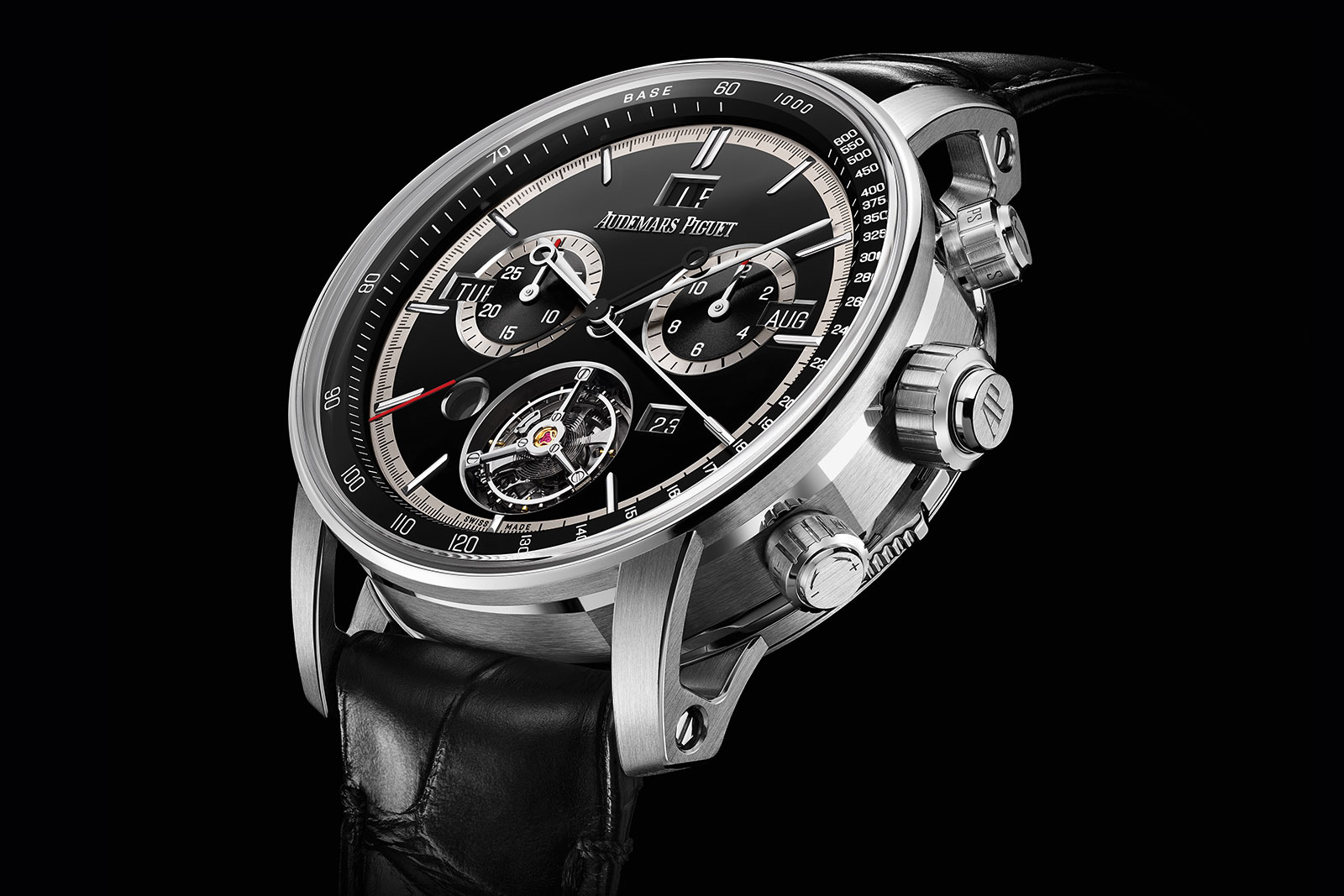
The three crowns with coaxial pushers on the right flank of the Universelle RD#4’s case
The lower crown at four o’clock is perhaps the most ergonomic innovation in terms of interactivity. The crown can be rotated back and forth to adjust the month of the calendar in both directions, hence the “+” and “-” symbols engraved on the top.
This is a thoughtful function that simplifies the perpetual calendar setting significantly, as oppose to a conventional setting mechanism that relies on tiny pushers in the case that requires a tool to operate. Moreover, such correctors usually only adjust forwards and not backwards, requiring the wearer to go through an entire cycle if the calendar is advanced beyond the current date.
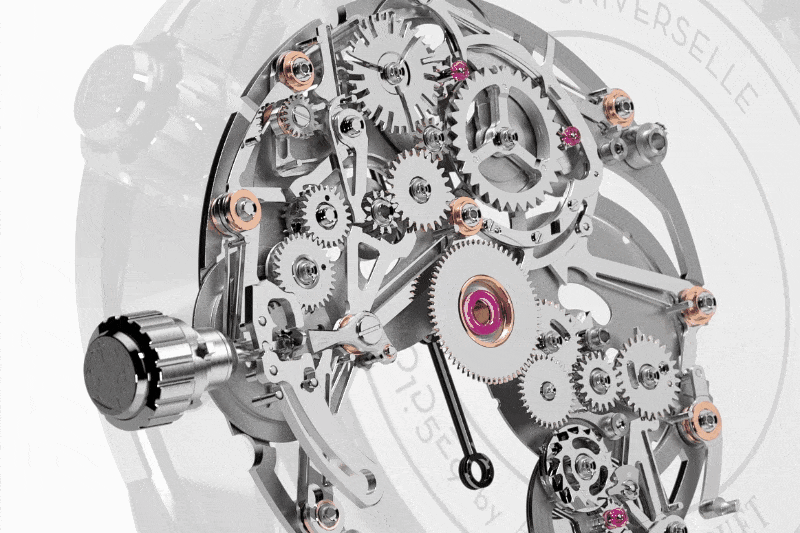
The crown at four o’clock for quick adjustment of the month – in this example, backwards
Concluding thoughts
The Universelle RD#4 and its cal. 1000 is unquestionably an impressive feat of horological engineering that balances complexity and ergonomics in a landmark watch. AP succeeded in achieving its goal of a wearable and useable ultra-complication.
Although it would be difficult to better the Universelle RD#4 in terms of ergonomics, it could be made even more complicated – a full secular perpetual calendar would be an interesting addition, which is certainly within the capabilities of AP and its technical bureau at the Le Locle manufacture (formerly Renaud & Papi), but that could come at the expense of wearability since it would bulk up the watch.
Beyond the watch itself, the possibility of the cal. 1000 innovations trickling down into future calibres is tantalising, as it would make the clever technical solutions of the Universelle RD#4 more accessible. While the compact design of a split-seconds embedded within a rotor hub is already found in a Royal Oak Concept, the compact moon phase and crown-adjustable perpetual calendar are the most readily adaptable to other movements.
Key facts and price
Code 11.59 by Audemars Piguet Universelle
Ref. 26398BC.OO.D002CR.01 (white gold, black dial)
Ref. 26398BC.OO.D002CR.04 (white gold, beige dial)
Ref. 26398BC.OO.D002CR.02 (white gold, openworked dial)
Ref. 26398OR.OO.D002CR.01 (pink gold, openworked dial)
Diameter: 42 mm
Height: 15.55 mm
Material: 18k white gold or pink gold
Crystal: Sapphire
Water resistance: 20 m
Movement: Cal. 1000
Functions: Flying tourbillon, big date, moon phase, perpetual calendar, split-seconds chronograph, grand and petite sonnerie, minute repeater
Winding: Automatic
Frequency: 21,600 beats per hour (3 Hz)
Power reserve: 64 hours
Strap: Leather strap with matching 18k gold folding clasp
Limited edition: No
Availability: At AP boutiques and AP Houses
Price: CHF1.6 million with open dial; CHF1.45 million with solid dial (prices exclude taxes)
For more on the Universelle RD#4, visit Audemarspiguet.com.
This was brought to you in partnership with Audemars Piguet.
Back to top.


